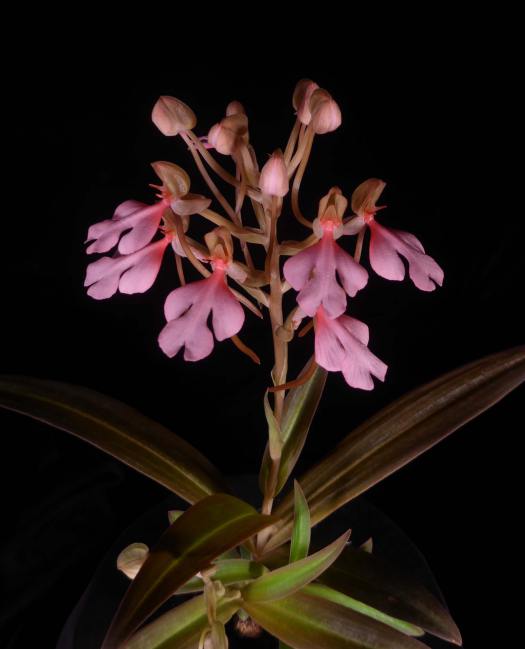August 2020
From Richard Hess:
|
|
 Cattleya (Laelia) tenebrosa |
|
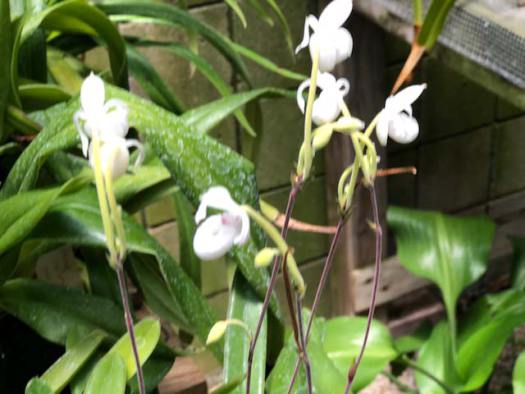 Mexipedium xerophyticum |
 IMG_2997.jpg) Eulophia guineensis (quartiniana) |
From Janet Wilson: |
|
 Eulophia petersiiWe have always tried to keep Eulophia petersii out of the rain because that’s what you’re supposed to do. But it hasn’t bloomed for 4 years. This time, we left it out, and took advice from a 2008 SDCOS newsletter to “burn it.” That seems to have worked. |
|

Encyclia guatemalensisEnc. guatemalensis is a good beginner’s orchid. It does well out in the backyard here in inland OC. The lighting is moderate (some morning direct sun but otherwise 75% shade cloth) and it thrives on the local (hard) tap water. |
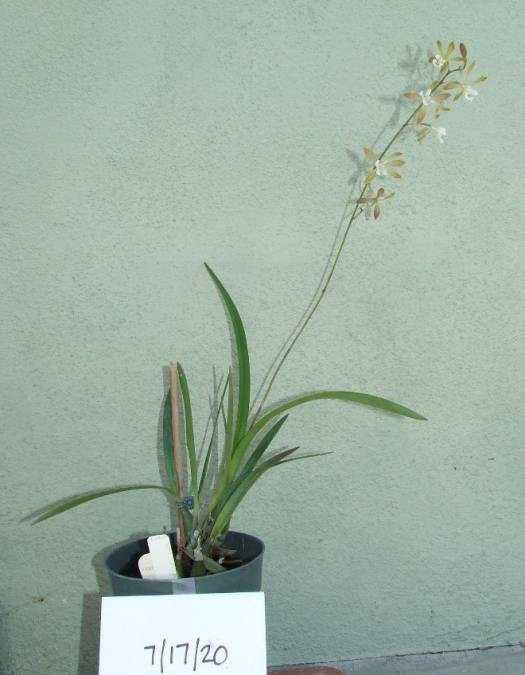 |
From Scott McGregor:
|
|
Angraecum magdalanaeOne of my favorite Angraecums—grows well outdoors and has the most wonderful clove-scented flowers. It grows into a compact clump over time. |
Cattleya (Laelia) purpurata f. carneaOne of my favorite Angraecums—grows well outdoors and has the most wonderful clove-scented flowers. It grows into a compact clump over time. |
Cleisostoma scolopenrifoliumA very tiny vandaceous vine from China. A bit shy flowering (for me at least) and easy to miss! Compare the size of flower with the 15 pound test monofilament or the tip of my finger… |
Dendrobium hercoglossumA mini summer-blooming semi-deciduous Dendrobium from Thailand. |
Cynorkis fastigiataIf I could, I would rename this species Cynorkis weedii! Andy Phillips gave me one of these in 2013 as a bonus plant and I admired the small but pretty flowers (first pic), and the rapidly forming and maturing seed pods. The next Spring, it sprouted all over my collection and I was initially delighted with the result, but soon vowed to pull it up when I found it and never let it form seed pods. I’ve got it mostly back under control now and am back to enjoying it popping up now and again. Funny though, it seems to prefer growing with other orchids (pic 2, in a large Dendrobium speciosum pot), and doesn’t seem to grow well for me if I actually give it a pot of its own (3rd pic)! Grows well outside but is deciduous and late to sprout, so you won’t know where it will turn up until summer. I should have some seed pods in August if you want to visit and infect your own growing area! |
|
Dendrobium devonianumAnother colorful and delightfully fringed Dendrobium from Thailand. I grow these bright and outside all year (including getting rained on in the winter). |
|
Dendrobium glomeratum
|
|
Dichaea glaucaThese put up new canes each year and bloom off of both new and old canes, and so a large plant can put on a pretty good show. The individual flowers aren’t very big, but they are intensely fragrant, and a mass of them will perfume the room. |
|
 |

Dracula roezliiLots of Dracula flowers in the summer. D. roezlii has dark flowers covered with short hairs. Draculas are best if you live within a few miles of the coast as they resent Santa Ana hot/dry winds, but are tougher than you might think. I find them easier to grow than Masdevallias and mine not only survived the 115F high we had a few summers ago, but bloomed a couple days afterwards. Their flowers can fade on a hot day, but usually perk up the next morning if they get a cool night’s rest.
|
Encyclia bractescensThis one isn’t flashy, but can grow into a nice specimen, creating a ball of widely spaced flowers. |
|

Lycaste aromaticaEvery collection should have a pot of Lycaste aromatica—they are easy growers and have a powerful and pleasant sweet cinnamon fragrance. |
Rhyncholaelia digbyanaThe best for summer fringe and a lemony fragrance as well! Grows indoors or out. |
Pleurothallis sarracenia
|
|
Schoenorchis gemmataVandacious species from Java with very small but colorful flowers (1-2mm) progressively opening over many weeks. |
|
Schoenorchis scolopendriaA very mini creeping vandaceous species from Vietnam nicknamed the “millipede orchid”. In bright light the leaves become dark red. |
|
 |
 |
Sobralia sanderaeIf you have this species, no need to get the fancy hybrid Sobralias! Compare the two pics of S. sanderae (this year and last year) with primary hybrid S. decora X macrantha—they could be twins... |
|
 Sobralia (decora x macrantha) |
Sobralia rogersiana 'deBrito'I love Sobralias blooming in the summer—the flowers are short-lived, but new ones appear sequentially at the ends of long canes. The biggest of them all is S. rogersiana, which used by be sold as S. macrantha ‘Bolin’, before it became a separate species. It is a strong candidate for largest square inches of lip for any orchid flower. |
Stanhopea hernandeziiMy first Stanhopea to bloom this summer. Grows easily in the shade under a bench or other plants, and intensely fragrant with large waxy flowers that last 2-3 days. The large spring-loaded buds literally pop open and fully deploy within a minute or two. |
|
Trichopilia hennisianaThis one hasn’t bloomed for a couple years, so nice to see it back! Showy white flowers, but unfortunately not particularly fragrant.
|
|
Stenoglottis macloughlinii (originally sold as woodii)A cheerful pot of mini pink flowers. I had trouble growing this one shady (leaf die-back, few flowers) -- it seems to be happier with fairly bright light. |
|
Vanda (Neofinetia) falcata 'Ksyu-Ryoku-Ju'One of the many named varieties of this species—I still can’t get over this being reclassified as a “Vanda” as I still think of it as the Japanese Angraecum genus “Neofinetia”. The many small white flowers are sweetly scented at night. Other varieties, shown for reference include ‘Shutteno' which has pink flowers, and 'Suruga Fukarin’ which has tiger-striped variegated leaves. |
 Vanda (Neofinetia) falcata 'Shutenno' |
Vanda (Neofinetia) falcata 'Suruga-Fukurin' |
|
From Roberta Fox:
|
|
Outside in the Back Yard: |
|
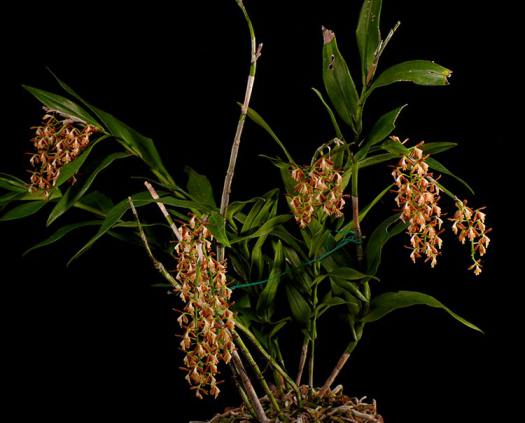 Epidendrum polyanthumOver time, the leaves drop off, but the canes continue to produce flowers - they look dead but as long as there is green and they are firm, they are very much alive. (Don't cut anything that isn't brown and crispy!) After repotting, it is producing many new, leafy growths, but these old ones (left) just keep going. The photo above was taken several years ago, when it had both leafed and leafless canes. |
|

Stanhopea tigrinaMore red than the closely-related Stan. tigrina var. nigroviolacea that some of us have. This one teased me for about a week, with huge buds looking like they were going to pop at any minute. Last year it ALMOST bloomed, then blasted. I think that was just too young, but I was afraid that it would disappoint me again. I was finally greeted one morning by the open, heavily-fragrant flowers. The fragrance is almost musky. I have found that Stanhopeas need to be kept quite damp, and on the shady side. Alas, the flowers are rather short-lived, only a few days. You just have to be there! |
|
 Bulbophyllum (Cirrhopetalum) hirundinisBlooms several times a year. This grows shady and damp - does just fine outside. Colors are dramatic. |
|
Bulbophyllum brevibrachiatumColor similar to B. hirundinis, but flowers are about half the size. With both in bloom at the same time, that shady spot seems very bright. |
|
Schoenorchis juncifoliaThe inflorescences remind me a little of wisteria. The plant is attached to a small tree-fern (hapu'u) pole, but has far outgrown it. The roots of the newer parts of the plant hang free and seem quite satisfied to do so. Its growth is mostly vertical so it doesn't occupy a lot of space as it gets big. |
|
 |
|
Gongora maculataRelated to Stanhopea. Inflorescences grow from the side or bottom of the basket. |
|
 |
 |
Maxillaria marginataThe plant is somewhat of a rambler, expanding beyond an 10 inch basket. I find the flowers, with the contrast of the dark burgundy markings on a cream background, very dramatic. |
|
 Eulophia speciosaThis species occurs throughout east Africa, from the Cape through Ethiopia, and even into Yemen. I am growing it in pure sand... that is the way I got it, when I repotted to divide it I just put it back in the same. I don't water in winter, but don't protect it from rain so it does get some water. It blooms sequentially, for several months. Last year it continuted to bloom into October. |
 |
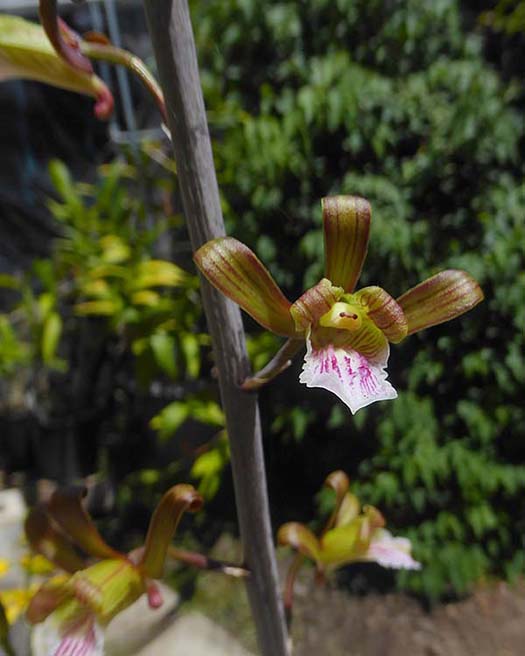
Eulophia petersiiFor a good view of the whole plant, check Janet Wilson's photo. Spike can easily be 4-5 feet in length, or longer. This is another desert-dweller. I grow it in pea gravel (approximately 1/4 inch pieces). |
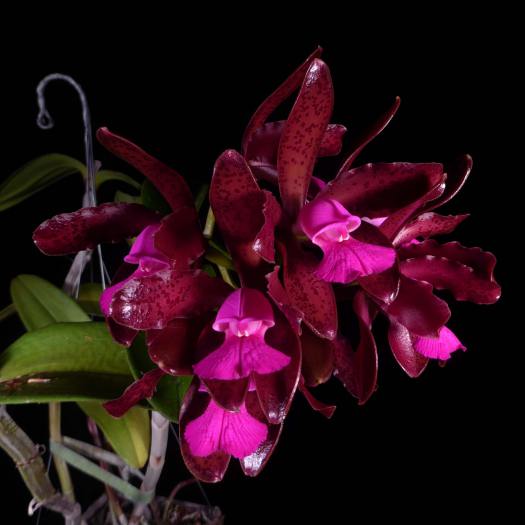
Cattleya tigrina (leopoldii)A big head of flowers with heavy substance, on a tall pseudobulb. The footprint of this species stays reasonable, but the pseudobulbs are 18-20 inches. The segments vary on different plants from greenish with brown spots to very dark brown, but always with the brilliant lip. There is also an alba form. |

Rhyncholaelia digbyanaIt's the season! This one is the alba form - no red pigment at all on any part of the flower. (Typically the front of the flower has little or no pigment, but the back sides of the segments are somewhat pink.) |
|
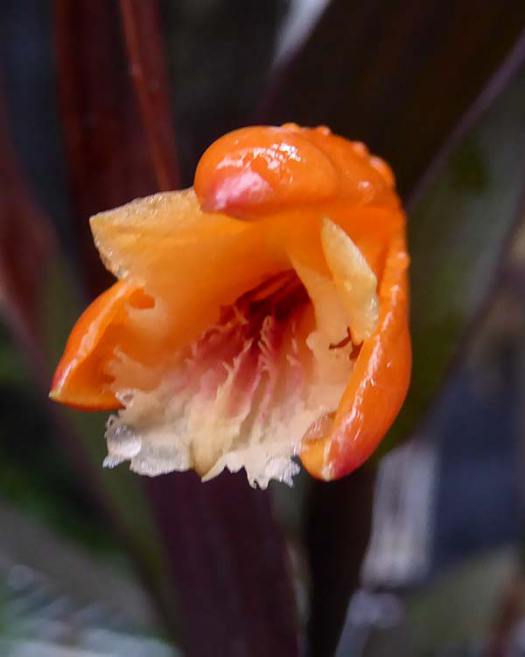 |
|
Sobralia croceaGrows shady and damp. The flowers are about an inch long, and don't open fully. Like Sobralias in general, flowers are short-lived but are produced over a period of several months. |
|
 |
|
Vanda flabellataA small plant, from south-central China and southeast Asia. It grows over a wide range of elevations. |
|
 |
 |
Scaphosepalum swertifolium ssp. exiguumThis genus is really fun. Small flowers are intricate, best appreciated in a photograph. This subspecies is a bit more colorful than the main species. This plant blooms on and off throought the year, this summer produced a particularly good flush bloom. |
|
 |
 |
Dracula woodwardiiThis one is quite hairy. Like Scott, I have found Draculas easier, in general, than Masdevallias in tolerating summer temperatures. Like many in the genus, the flowers some from the side or bottom of the plant, requiring that they be grown in baskets. |
|

Renanthera imschootianaThis species originates in the east Himalaya, northern India and south-central China, at elevations from around 1000-1500 m. I have it in a plastic basket, but most of the roots are hanging free. It lost the original crown, but produced several keikis and basal growths which are blooming profusely. I received this plant from Richard Hess. Thanks, Richard! |
 |
 |

Dendrobium (Diplocaulobium) stelliferumUnlike most Diplocaulobiums (such as Dcm. aratriferum) that barely last a day, the flowers stay for 4-5 days. This is a relatively recent acquisition, so I have not yet determined whether it blooms as often as Dcm. aratriferum. |
 |
 |
Dendrobium cucumerinumThe leaves look like little gherkins. The flowers are just odd, but quite attractive in close-up. |
|
Vanda (Neofinetia) falcataHere are two nice pink forms. Above is ''Beni-suzume' and to the right is 'Kohkakuden'. My classic white ones are just getting started. All of them have a delicious scent, stronger in the evening, that reminds me of vanilla.
|
 |
 |
 |
Stenoglottis woodiiThis one is just for reference... the Stenoglottis macloughlinii shown by Scott was originally sold as Sngl. woodii... this is the correct Sngl. woodii. Bigger plant, fewer flowers more widely spaced... I think Scott's Sngl. macloughlinii is much nicer! |
|
In the greenhouse... |
|
 |
 |
Dendrobium venustumA miniature plant, about 3 inches tall. I love the fringed lip. |
|
 |
 |
Bulbophyllum frostiiRelatively large flowers, remeniscent of a pair of Dutch shoes. |
|
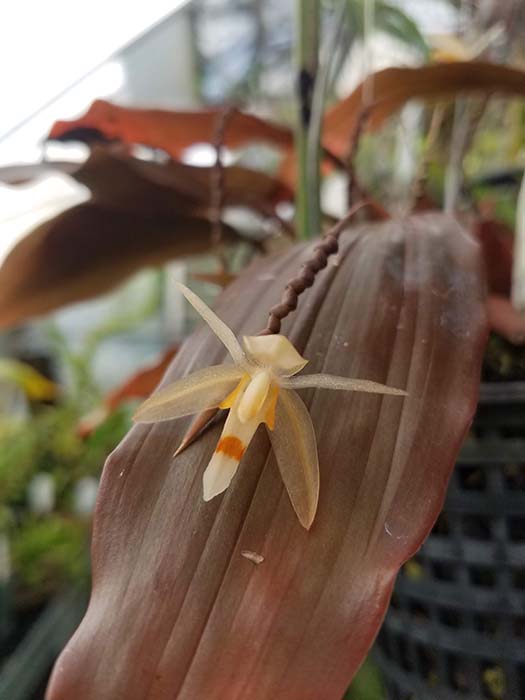
Coelogyne monilirachisThis plant blooms repeatedly on each inflorescence. The spikes tend to be pendant due to the weight of the flower, so can be tricky to photograph. This one happened to present itself nicely on the bronze leaf, showing both nicely. |

Pleurothallis tribuloidesSmall but brilliant flowers that cluster at the base of the leaves. |
.jpg)


















